MMS711 - Future of Sport: Organization, Management & Delivery
VerifiedAdded on 2023/06/11
|18
|6861
|236
Essay
AI Summary
This essay delves into the future of Australian sports, examining the current 'four pyramids of sport' structure and its implications for management, organization, and delivery. It explores the shift towards individualized sports and the increasing importance of health consciousness among Australians. The essay analyzes emerging challenges such as an aging population, resource competition, drug use, and the management of new sports. It also discusses evolving models of sports organization, including cluster formations, and their potential impact on the Australian sports industry. The report concludes by emphasizing the need for adaptability and innovation to ensure the continued success and development of Australian sports.

Australian Sports future 1
Australian Sports future
Australian Sports future
Paraphrase This Document
Need a fresh take? Get an instant paraphrase of this document with our AI Paraphraser
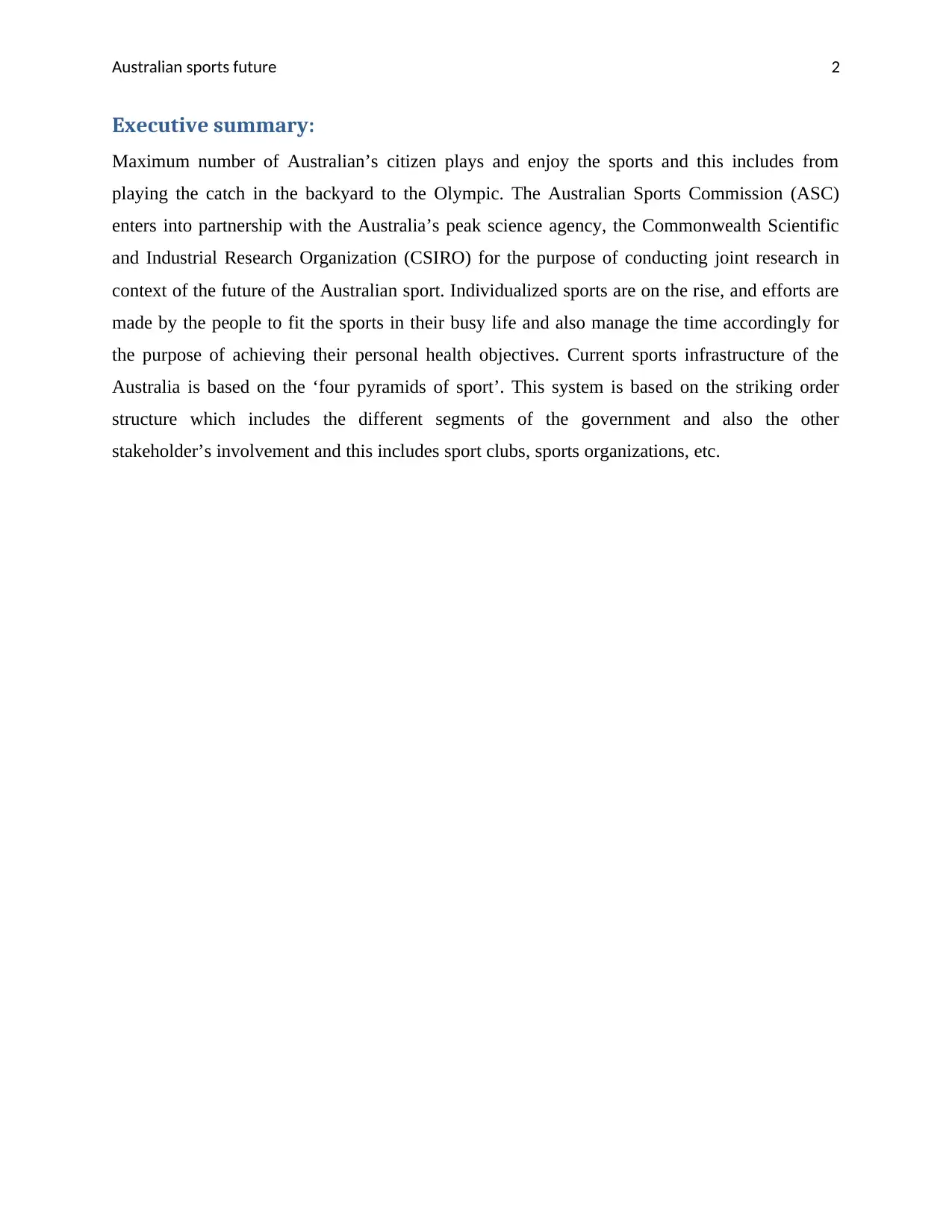
Australian sports future 2
Executive summary:
Maximum number of Australian’s citizen plays and enjoy the sports and this includes from
playing the catch in the backyard to the Olympic. The Australian Sports Commission (ASC)
enters into partnership with the Australia’s peak science agency, the Commonwealth Scientific
and Industrial Research Organization (CSIRO) for the purpose of conducting joint research in
context of the future of the Australian sport. Individualized sports are on the rise, and efforts are
made by the people to fit the sports in their busy life and also manage the time accordingly for
the purpose of achieving their personal health objectives. Current sports infrastructure of the
Australia is based on the ‘four pyramids of sport’. This system is based on the striking order
structure which includes the different segments of the government and also the other
stakeholder’s involvement and this includes sport clubs, sports organizations, etc.
Executive summary:
Maximum number of Australian’s citizen plays and enjoy the sports and this includes from
playing the catch in the backyard to the Olympic. The Australian Sports Commission (ASC)
enters into partnership with the Australia’s peak science agency, the Commonwealth Scientific
and Industrial Research Organization (CSIRO) for the purpose of conducting joint research in
context of the future of the Australian sport. Individualized sports are on the rise, and efforts are
made by the people to fit the sports in their busy life and also manage the time accordingly for
the purpose of achieving their personal health objectives. Current sports infrastructure of the
Australia is based on the ‘four pyramids of sport’. This system is based on the striking order
structure which includes the different segments of the government and also the other
stakeholder’s involvement and this includes sport clubs, sports organizations, etc.
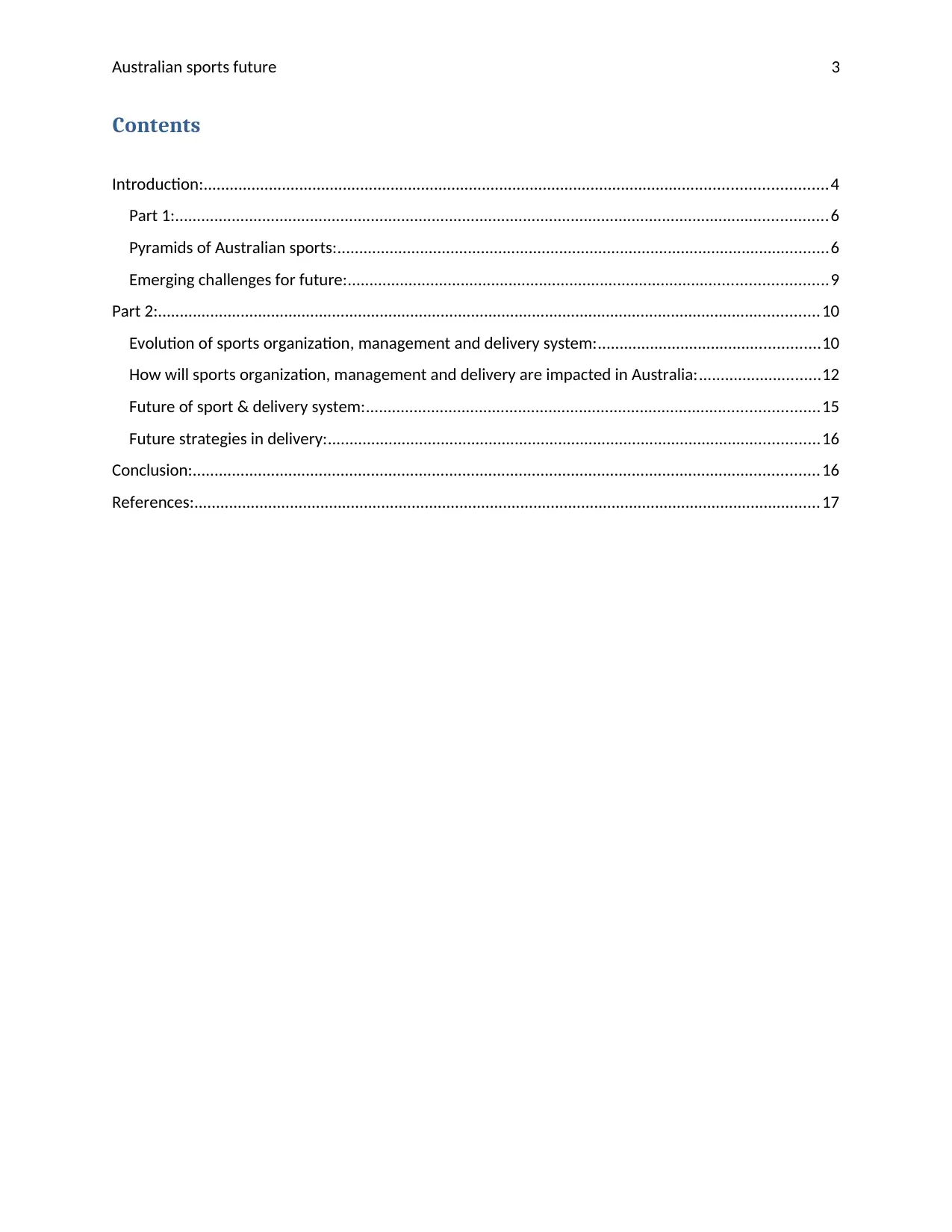
Australian sports future 3
Contents
Introduction:...............................................................................................................................................4
Part 1:......................................................................................................................................................6
Pyramids of Australian sports:.................................................................................................................6
Emerging challenges for future:..............................................................................................................9
Part 2:........................................................................................................................................................10
Evolution of sports organization, management and delivery system:...................................................10
How will sports organization, management and delivery are impacted in Australia:............................12
Future of sport & delivery system:........................................................................................................15
Future strategies in delivery:.................................................................................................................16
Conclusion:................................................................................................................................................16
References:................................................................................................................................................17
Contents
Introduction:...............................................................................................................................................4
Part 1:......................................................................................................................................................6
Pyramids of Australian sports:.................................................................................................................6
Emerging challenges for future:..............................................................................................................9
Part 2:........................................................................................................................................................10
Evolution of sports organization, management and delivery system:...................................................10
How will sports organization, management and delivery are impacted in Australia:............................12
Future of sport & delivery system:........................................................................................................15
Future strategies in delivery:.................................................................................................................16
Conclusion:................................................................................................................................................16
References:................................................................................................................................................17
⊘ This is a preview!⊘
Do you want full access?
Subscribe today to unlock all pages.

Trusted by 1+ million students worldwide
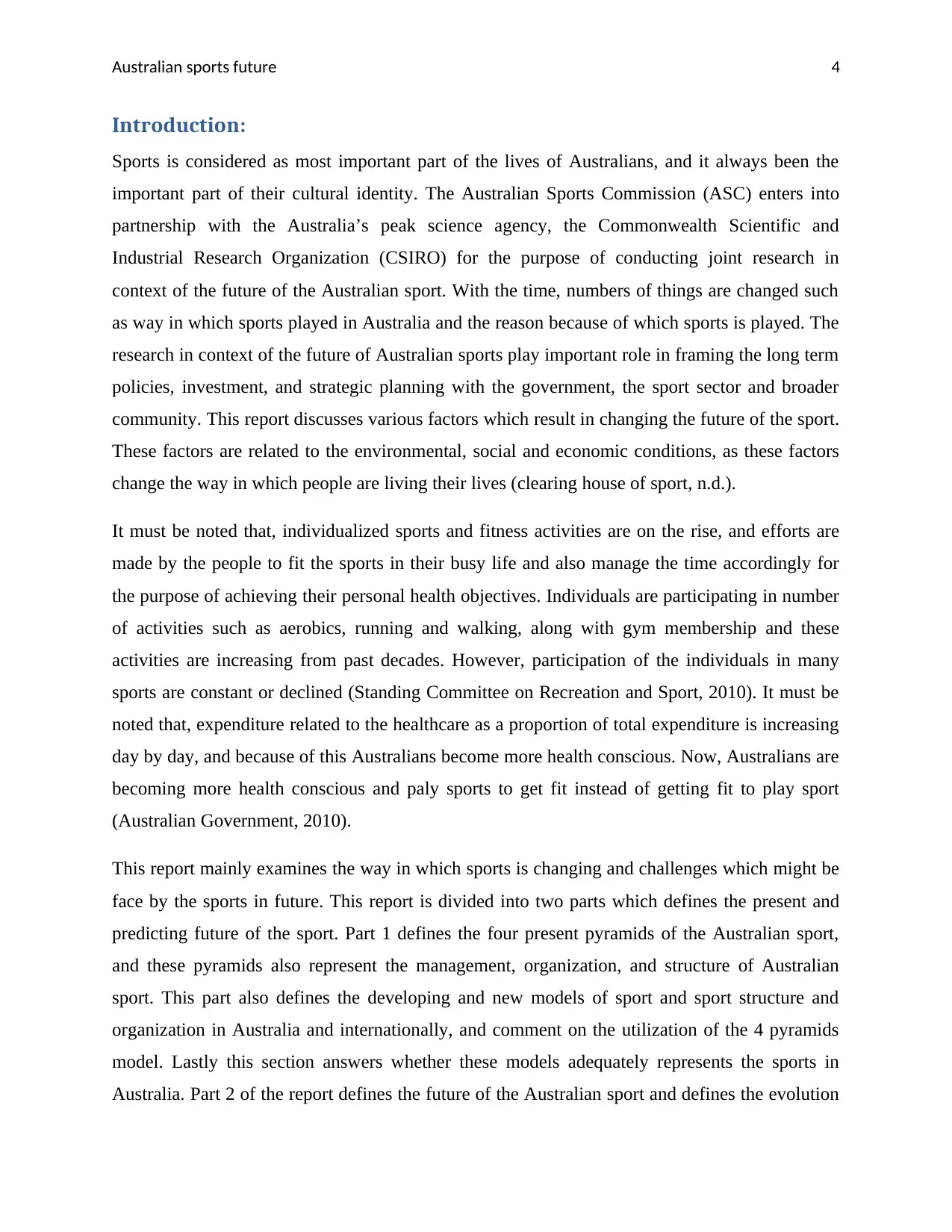
Australian sports future 4
Introduction:
Sports is considered as most important part of the lives of Australians, and it always been the
important part of their cultural identity. The Australian Sports Commission (ASC) enters into
partnership with the Australia’s peak science agency, the Commonwealth Scientific and
Industrial Research Organization (CSIRO) for the purpose of conducting joint research in
context of the future of the Australian sport. With the time, numbers of things are changed such
as way in which sports played in Australia and the reason because of which sports is played. The
research in context of the future of Australian sports play important role in framing the long term
policies, investment, and strategic planning with the government, the sport sector and broader
community. This report discusses various factors which result in changing the future of the sport.
These factors are related to the environmental, social and economic conditions, as these factors
change the way in which people are living their lives (clearing house of sport, n.d.).
It must be noted that, individualized sports and fitness activities are on the rise, and efforts are
made by the people to fit the sports in their busy life and also manage the time accordingly for
the purpose of achieving their personal health objectives. Individuals are participating in number
of activities such as aerobics, running and walking, along with gym membership and these
activities are increasing from past decades. However, participation of the individuals in many
sports are constant or declined (Standing Committee on Recreation and Sport, 2010). It must be
noted that, expenditure related to the healthcare as a proportion of total expenditure is increasing
day by day, and because of this Australians become more health conscious. Now, Australians are
becoming more health conscious and paly sports to get fit instead of getting fit to play sport
(Australian Government, 2010).
This report mainly examines the way in which sports is changing and challenges which might be
face by the sports in future. This report is divided into two parts which defines the present and
predicting future of the sport. Part 1 defines the four present pyramids of the Australian sport,
and these pyramids also represent the management, organization, and structure of Australian
sport. This part also defines the developing and new models of sport and sport structure and
organization in Australia and internationally, and comment on the utilization of the 4 pyramids
model. Lastly this section answers whether these models adequately represents the sports in
Australia. Part 2 of the report defines the future of the Australian sport and defines the evolution
Introduction:
Sports is considered as most important part of the lives of Australians, and it always been the
important part of their cultural identity. The Australian Sports Commission (ASC) enters into
partnership with the Australia’s peak science agency, the Commonwealth Scientific and
Industrial Research Organization (CSIRO) for the purpose of conducting joint research in
context of the future of the Australian sport. With the time, numbers of things are changed such
as way in which sports played in Australia and the reason because of which sports is played. The
research in context of the future of Australian sports play important role in framing the long term
policies, investment, and strategic planning with the government, the sport sector and broader
community. This report discusses various factors which result in changing the future of the sport.
These factors are related to the environmental, social and economic conditions, as these factors
change the way in which people are living their lives (clearing house of sport, n.d.).
It must be noted that, individualized sports and fitness activities are on the rise, and efforts are
made by the people to fit the sports in their busy life and also manage the time accordingly for
the purpose of achieving their personal health objectives. Individuals are participating in number
of activities such as aerobics, running and walking, along with gym membership and these
activities are increasing from past decades. However, participation of the individuals in many
sports are constant or declined (Standing Committee on Recreation and Sport, 2010). It must be
noted that, expenditure related to the healthcare as a proportion of total expenditure is increasing
day by day, and because of this Australians become more health conscious. Now, Australians are
becoming more health conscious and paly sports to get fit instead of getting fit to play sport
(Australian Government, 2010).
This report mainly examines the way in which sports is changing and challenges which might be
face by the sports in future. This report is divided into two parts which defines the present and
predicting future of the sport. Part 1 defines the four present pyramids of the Australian sport,
and these pyramids also represent the management, organization, and structure of Australian
sport. This part also defines the developing and new models of sport and sport structure and
organization in Australia and internationally, and comment on the utilization of the 4 pyramids
model. Lastly this section answers whether these models adequately represents the sports in
Australia. Part 2 of the report defines the future of the Australian sport and defines the evolution
Paraphrase This Document
Need a fresh take? Get an instant paraphrase of this document with our AI Paraphraser
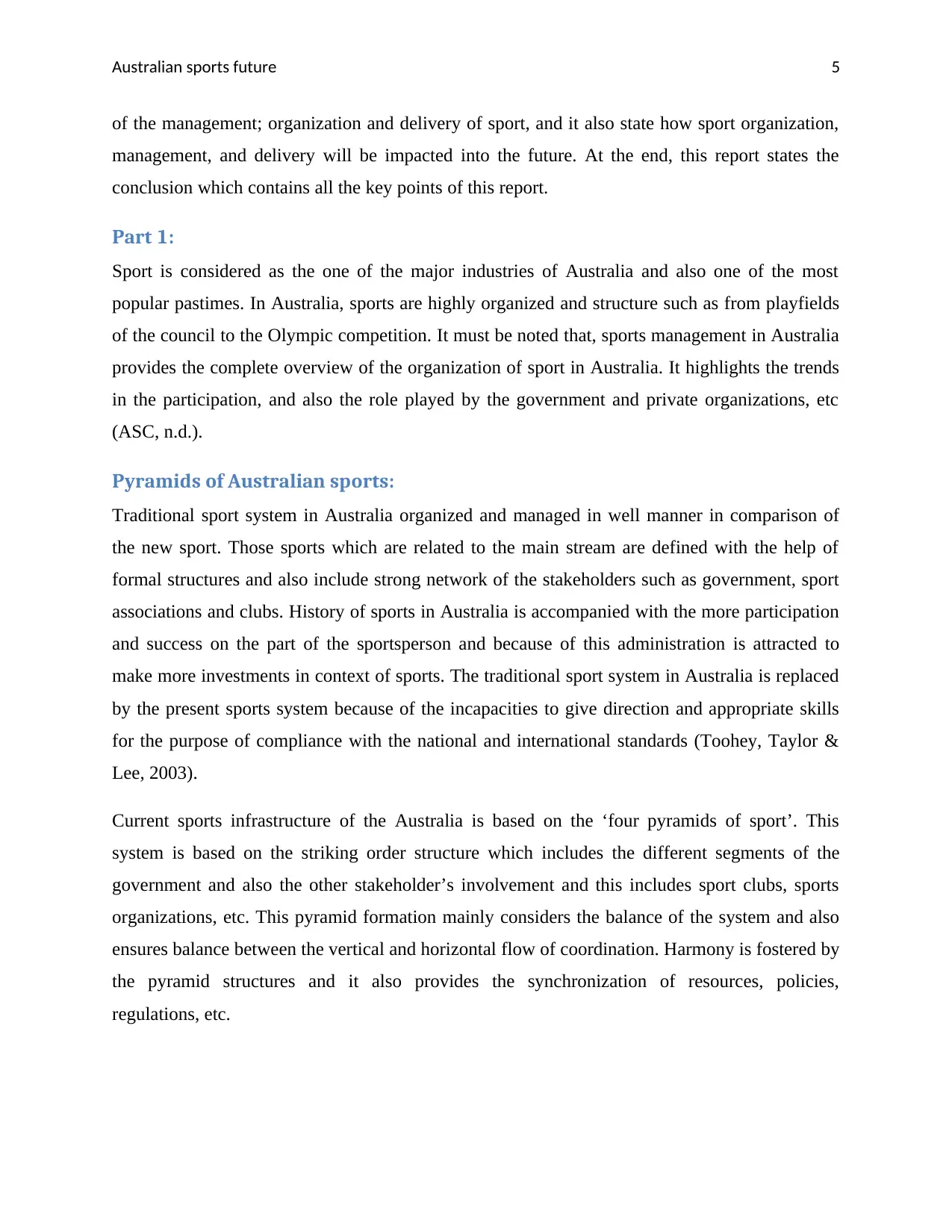
Australian sports future 5
of the management; organization and delivery of sport, and it also state how sport organization,
management, and delivery will be impacted into the future. At the end, this report states the
conclusion which contains all the key points of this report.
Part 1:
Sport is considered as the one of the major industries of Australia and also one of the most
popular pastimes. In Australia, sports are highly organized and structure such as from playfields
of the council to the Olympic competition. It must be noted that, sports management in Australia
provides the complete overview of the organization of sport in Australia. It highlights the trends
in the participation, and also the role played by the government and private organizations, etc
(ASC, n.d.).
Pyramids of Australian sports:
Traditional sport system in Australia organized and managed in well manner in comparison of
the new sport. Those sports which are related to the main stream are defined with the help of
formal structures and also include strong network of the stakeholders such as government, sport
associations and clubs. History of sports in Australia is accompanied with the more participation
and success on the part of the sportsperson and because of this administration is attracted to
make more investments in context of sports. The traditional sport system in Australia is replaced
by the present sports system because of the incapacities to give direction and appropriate skills
for the purpose of compliance with the national and international standards (Toohey, Taylor &
Lee, 2003).
Current sports infrastructure of the Australia is based on the ‘four pyramids of sport’. This
system is based on the striking order structure which includes the different segments of the
government and also the other stakeholder’s involvement and this includes sport clubs, sports
organizations, etc. This pyramid formation mainly considers the balance of the system and also
ensures balance between the vertical and horizontal flow of coordination. Harmony is fostered by
the pyramid structures and it also provides the synchronization of resources, policies,
regulations, etc.
of the management; organization and delivery of sport, and it also state how sport organization,
management, and delivery will be impacted into the future. At the end, this report states the
conclusion which contains all the key points of this report.
Part 1:
Sport is considered as the one of the major industries of Australia and also one of the most
popular pastimes. In Australia, sports are highly organized and structure such as from playfields
of the council to the Olympic competition. It must be noted that, sports management in Australia
provides the complete overview of the organization of sport in Australia. It highlights the trends
in the participation, and also the role played by the government and private organizations, etc
(ASC, n.d.).
Pyramids of Australian sports:
Traditional sport system in Australia organized and managed in well manner in comparison of
the new sport. Those sports which are related to the main stream are defined with the help of
formal structures and also include strong network of the stakeholders such as government, sport
associations and clubs. History of sports in Australia is accompanied with the more participation
and success on the part of the sportsperson and because of this administration is attracted to
make more investments in context of sports. The traditional sport system in Australia is replaced
by the present sports system because of the incapacities to give direction and appropriate skills
for the purpose of compliance with the national and international standards (Toohey, Taylor &
Lee, 2003).
Current sports infrastructure of the Australia is based on the ‘four pyramids of sport’. This
system is based on the striking order structure which includes the different segments of the
government and also the other stakeholder’s involvement and this includes sport clubs, sports
organizations, etc. This pyramid formation mainly considers the balance of the system and also
ensures balance between the vertical and horizontal flow of coordination. Harmony is fostered by
the pyramid structures and it also provides the synchronization of resources, policies,
regulations, etc.
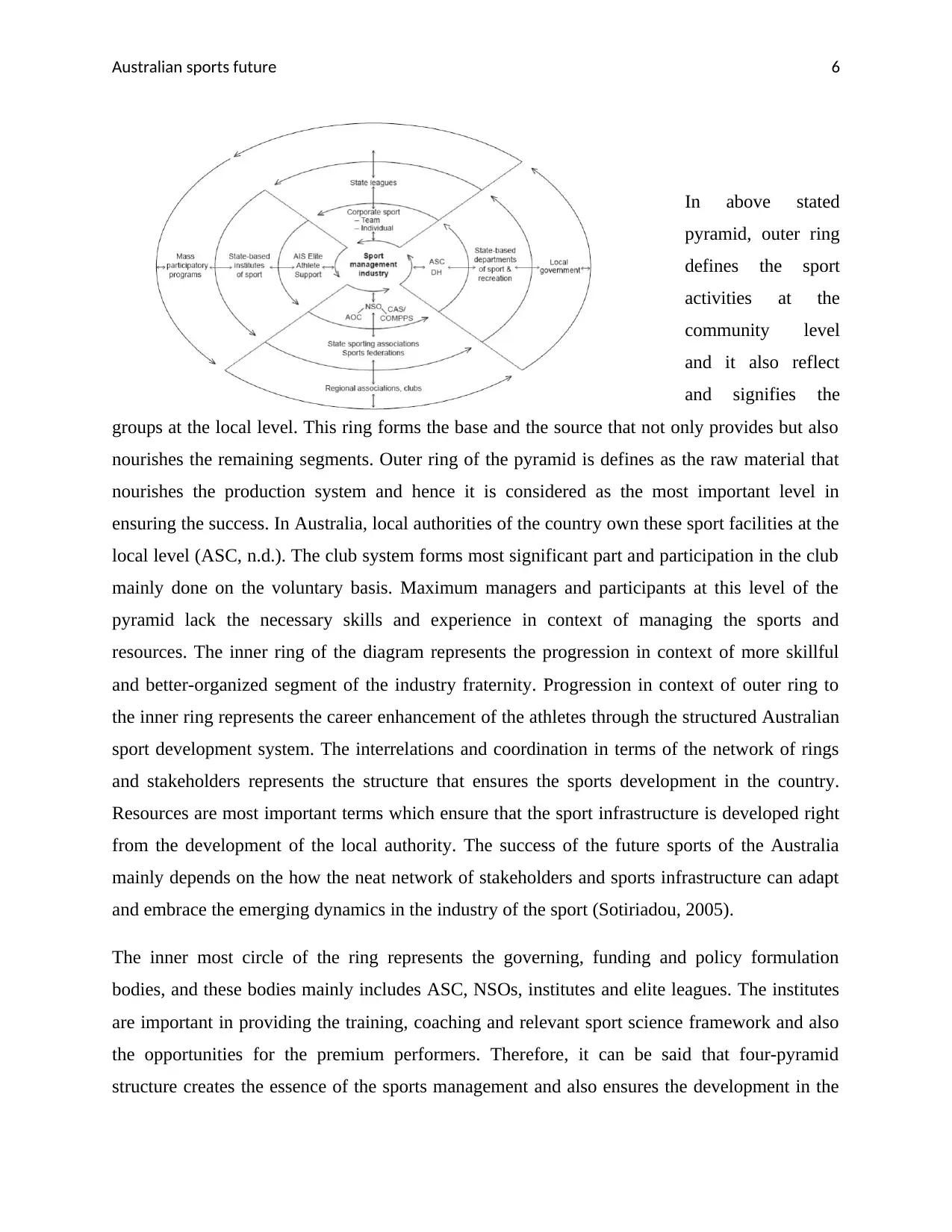
Australian sports future 6
In above stated
pyramid, outer ring
defines the sport
activities at the
community level
and it also reflect
and signifies the
groups at the local level. This ring forms the base and the source that not only provides but also
nourishes the remaining segments. Outer ring of the pyramid is defines as the raw material that
nourishes the production system and hence it is considered as the most important level in
ensuring the success. In Australia, local authorities of the country own these sport facilities at the
local level (ASC, n.d.). The club system forms most significant part and participation in the club
mainly done on the voluntary basis. Maximum managers and participants at this level of the
pyramid lack the necessary skills and experience in context of managing the sports and
resources. The inner ring of the diagram represents the progression in context of more skillful
and better-organized segment of the industry fraternity. Progression in context of outer ring to
the inner ring represents the career enhancement of the athletes through the structured Australian
sport development system. The interrelations and coordination in terms of the network of rings
and stakeholders represents the structure that ensures the sports development in the country.
Resources are most important terms which ensure that the sport infrastructure is developed right
from the development of the local authority. The success of the future sports of the Australia
mainly depends on the how the neat network of stakeholders and sports infrastructure can adapt
and embrace the emerging dynamics in the industry of the sport (Sotiriadou, 2005).
The inner most circle of the ring represents the governing, funding and policy formulation
bodies, and these bodies mainly includes ASC, NSOs, institutes and elite leagues. The institutes
are important in providing the training, coaching and relevant sport science framework and also
the opportunities for the premium performers. Therefore, it can be said that four-pyramid
structure creates the essence of the sports management and also ensures the development in the
In above stated
pyramid, outer ring
defines the sport
activities at the
community level
and it also reflect
and signifies the
groups at the local level. This ring forms the base and the source that not only provides but also
nourishes the remaining segments. Outer ring of the pyramid is defines as the raw material that
nourishes the production system and hence it is considered as the most important level in
ensuring the success. In Australia, local authorities of the country own these sport facilities at the
local level (ASC, n.d.). The club system forms most significant part and participation in the club
mainly done on the voluntary basis. Maximum managers and participants at this level of the
pyramid lack the necessary skills and experience in context of managing the sports and
resources. The inner ring of the diagram represents the progression in context of more skillful
and better-organized segment of the industry fraternity. Progression in context of outer ring to
the inner ring represents the career enhancement of the athletes through the structured Australian
sport development system. The interrelations and coordination in terms of the network of rings
and stakeholders represents the structure that ensures the sports development in the country.
Resources are most important terms which ensure that the sport infrastructure is developed right
from the development of the local authority. The success of the future sports of the Australia
mainly depends on the how the neat network of stakeholders and sports infrastructure can adapt
and embrace the emerging dynamics in the industry of the sport (Sotiriadou, 2005).
The inner most circle of the ring represents the governing, funding and policy formulation
bodies, and these bodies mainly includes ASC, NSOs, institutes and elite leagues. The institutes
are important in providing the training, coaching and relevant sport science framework and also
the opportunities for the premium performers. Therefore, it can be said that four-pyramid
structure creates the essence of the sports management and also ensures the development in the
⊘ This is a preview!⊘
Do you want full access?
Subscribe today to unlock all pages.

Trusted by 1+ million students worldwide
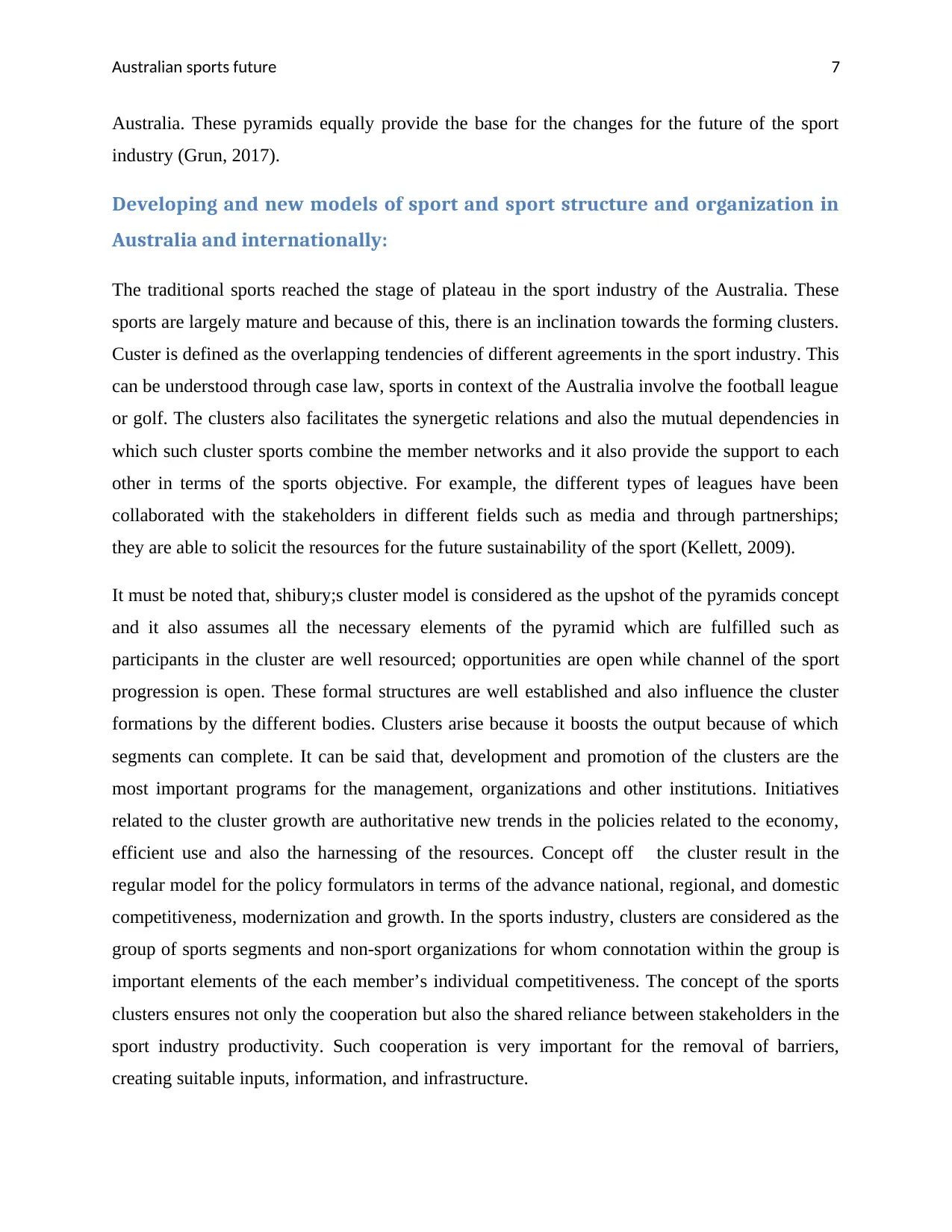
Australian sports future 7
Australia. These pyramids equally provide the base for the changes for the future of the sport
industry (Grun, 2017).
Developing and new models of sport and sport structure and organization in
Australia and internationally:
The traditional sports reached the stage of plateau in the sport industry of the Australia. These
sports are largely mature and because of this, there is an inclination towards the forming clusters.
Custer is defined as the overlapping tendencies of different agreements in the sport industry. This
can be understood through case law, sports in context of the Australia involve the football league
or golf. The clusters also facilitates the synergetic relations and also the mutual dependencies in
which such cluster sports combine the member networks and it also provide the support to each
other in terms of the sports objective. For example, the different types of leagues have been
collaborated with the stakeholders in different fields such as media and through partnerships;
they are able to solicit the resources for the future sustainability of the sport (Kellett, 2009).
It must be noted that, shibury;s cluster model is considered as the upshot of the pyramids concept
and it also assumes all the necessary elements of the pyramid which are fulfilled such as
participants in the cluster are well resourced; opportunities are open while channel of the sport
progression is open. These formal structures are well established and also influence the cluster
formations by the different bodies. Clusters arise because it boosts the output because of which
segments can complete. It can be said that, development and promotion of the clusters are the
most important programs for the management, organizations and other institutions. Initiatives
related to the cluster growth are authoritative new trends in the policies related to the economy,
efficient use and also the harnessing of the resources. Concept off the cluster result in the
regular model for the policy formulators in terms of the advance national, regional, and domestic
competitiveness, modernization and growth. In the sports industry, clusters are considered as the
group of sports segments and non-sport organizations for whom connotation within the group is
important elements of the each member’s individual competitiveness. The concept of the sports
clusters ensures not only the cooperation but also the shared reliance between stakeholders in the
sport industry productivity. Such cooperation is very important for the removal of barriers,
creating suitable inputs, information, and infrastructure.
Australia. These pyramids equally provide the base for the changes for the future of the sport
industry (Grun, 2017).
Developing and new models of sport and sport structure and organization in
Australia and internationally:
The traditional sports reached the stage of plateau in the sport industry of the Australia. These
sports are largely mature and because of this, there is an inclination towards the forming clusters.
Custer is defined as the overlapping tendencies of different agreements in the sport industry. This
can be understood through case law, sports in context of the Australia involve the football league
or golf. The clusters also facilitates the synergetic relations and also the mutual dependencies in
which such cluster sports combine the member networks and it also provide the support to each
other in terms of the sports objective. For example, the different types of leagues have been
collaborated with the stakeholders in different fields such as media and through partnerships;
they are able to solicit the resources for the future sustainability of the sport (Kellett, 2009).
It must be noted that, shibury;s cluster model is considered as the upshot of the pyramids concept
and it also assumes all the necessary elements of the pyramid which are fulfilled such as
participants in the cluster are well resourced; opportunities are open while channel of the sport
progression is open. These formal structures are well established and also influence the cluster
formations by the different bodies. Clusters arise because it boosts the output because of which
segments can complete. It can be said that, development and promotion of the clusters are the
most important programs for the management, organizations and other institutions. Initiatives
related to the cluster growth are authoritative new trends in the policies related to the economy,
efficient use and also the harnessing of the resources. Concept off the cluster result in the
regular model for the policy formulators in terms of the advance national, regional, and domestic
competitiveness, modernization and growth. In the sports industry, clusters are considered as the
group of sports segments and non-sport organizations for whom connotation within the group is
important elements of the each member’s individual competitiveness. The concept of the sports
clusters ensures not only the cooperation but also the shared reliance between stakeholders in the
sport industry productivity. Such cooperation is very important for the removal of barriers,
creating suitable inputs, information, and infrastructure.
Paraphrase This Document
Need a fresh take? Get an instant paraphrase of this document with our AI Paraphraser
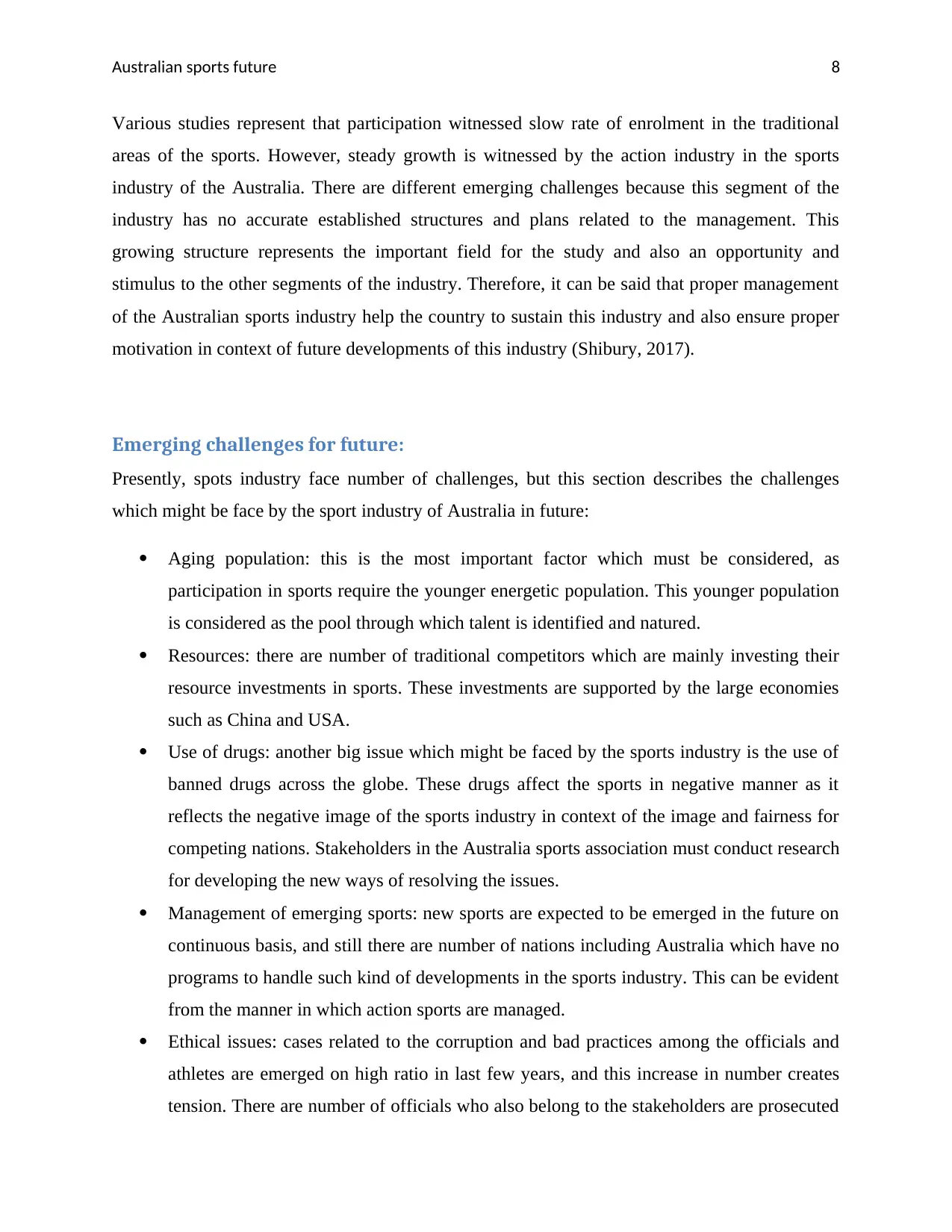
Australian sports future 8
Various studies represent that participation witnessed slow rate of enrolment in the traditional
areas of the sports. However, steady growth is witnessed by the action industry in the sports
industry of the Australia. There are different emerging challenges because this segment of the
industry has no accurate established structures and plans related to the management. This
growing structure represents the important field for the study and also an opportunity and
stimulus to the other segments of the industry. Therefore, it can be said that proper management
of the Australian sports industry help the country to sustain this industry and also ensure proper
motivation in context of future developments of this industry (Shibury, 2017).
Emerging challenges for future:
Presently, spots industry face number of challenges, but this section describes the challenges
which might be face by the sport industry of Australia in future:
Aging population: this is the most important factor which must be considered, as
participation in sports require the younger energetic population. This younger population
is considered as the pool through which talent is identified and natured.
Resources: there are number of traditional competitors which are mainly investing their
resource investments in sports. These investments are supported by the large economies
such as China and USA.
Use of drugs: another big issue which might be faced by the sports industry is the use of
banned drugs across the globe. These drugs affect the sports in negative manner as it
reflects the negative image of the sports industry in context of the image and fairness for
competing nations. Stakeholders in the Australia sports association must conduct research
for developing the new ways of resolving the issues.
Management of emerging sports: new sports are expected to be emerged in the future on
continuous basis, and still there are number of nations including Australia which have no
programs to handle such kind of developments in the sports industry. This can be evident
from the manner in which action sports are managed.
Ethical issues: cases related to the corruption and bad practices among the officials and
athletes are emerged on high ratio in last few years, and this increase in number creates
tension. There are number of officials who also belong to the stakeholders are prosecuted
Various studies represent that participation witnessed slow rate of enrolment in the traditional
areas of the sports. However, steady growth is witnessed by the action industry in the sports
industry of the Australia. There are different emerging challenges because this segment of the
industry has no accurate established structures and plans related to the management. This
growing structure represents the important field for the study and also an opportunity and
stimulus to the other segments of the industry. Therefore, it can be said that proper management
of the Australian sports industry help the country to sustain this industry and also ensure proper
motivation in context of future developments of this industry (Shibury, 2017).
Emerging challenges for future:
Presently, spots industry face number of challenges, but this section describes the challenges
which might be face by the sport industry of Australia in future:
Aging population: this is the most important factor which must be considered, as
participation in sports require the younger energetic population. This younger population
is considered as the pool through which talent is identified and natured.
Resources: there are number of traditional competitors which are mainly investing their
resource investments in sports. These investments are supported by the large economies
such as China and USA.
Use of drugs: another big issue which might be faced by the sports industry is the use of
banned drugs across the globe. These drugs affect the sports in negative manner as it
reflects the negative image of the sports industry in context of the image and fairness for
competing nations. Stakeholders in the Australia sports association must conduct research
for developing the new ways of resolving the issues.
Management of emerging sports: new sports are expected to be emerged in the future on
continuous basis, and still there are number of nations including Australia which have no
programs to handle such kind of developments in the sports industry. This can be evident
from the manner in which action sports are managed.
Ethical issues: cases related to the corruption and bad practices among the officials and
athletes are emerged on high ratio in last few years, and this increase in number creates
tension. There are number of officials who also belong to the stakeholders are prosecuted
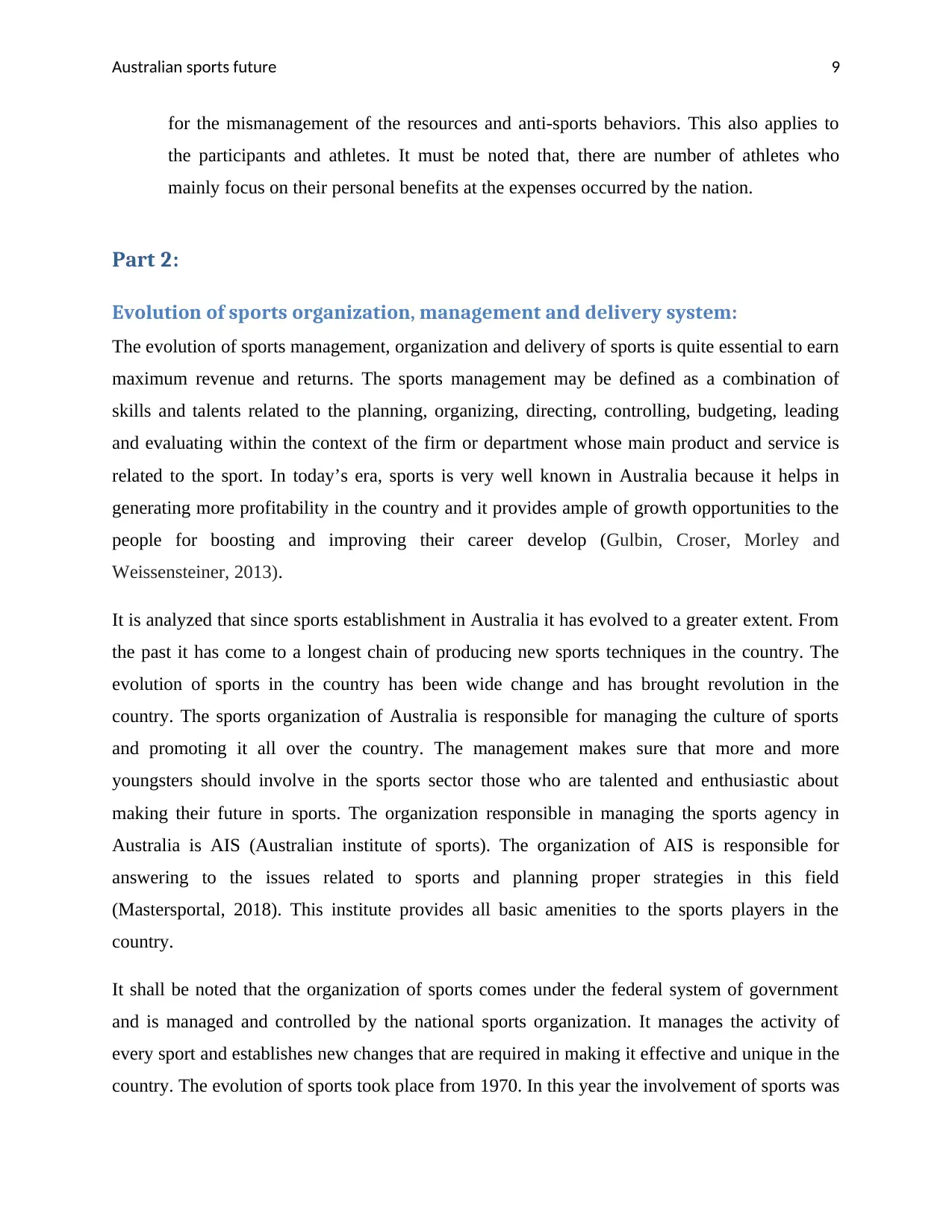
Australian sports future 9
for the mismanagement of the resources and anti-sports behaviors. This also applies to
the participants and athletes. It must be noted that, there are number of athletes who
mainly focus on their personal benefits at the expenses occurred by the nation.
Part 2:
Evolution of sports organization, management and delivery system:
The evolution of sports management, organization and delivery of sports is quite essential to earn
maximum revenue and returns. The sports management may be defined as a combination of
skills and talents related to the planning, organizing, directing, controlling, budgeting, leading
and evaluating within the context of the firm or department whose main product and service is
related to the sport. In today’s era, sports is very well known in Australia because it helps in
generating more profitability in the country and it provides ample of growth opportunities to the
people for boosting and improving their career develop (Gulbin, Croser, Morley and
Weissensteiner, 2013).
It is analyzed that since sports establishment in Australia it has evolved to a greater extent. From
the past it has come to a longest chain of producing new sports techniques in the country. The
evolution of sports in the country has been wide change and has brought revolution in the
country. The sports organization of Australia is responsible for managing the culture of sports
and promoting it all over the country. The management makes sure that more and more
youngsters should involve in the sports sector those who are talented and enthusiastic about
making their future in sports. The organization responsible in managing the sports agency in
Australia is AIS (Australian institute of sports). The organization of AIS is responsible for
answering to the issues related to sports and planning proper strategies in this field
(Mastersportal, 2018). This institute provides all basic amenities to the sports players in the
country.
It shall be noted that the organization of sports comes under the federal system of government
and is managed and controlled by the national sports organization. It manages the activity of
every sport and establishes new changes that are required in making it effective and unique in the
country. The evolution of sports took place from 1970. In this year the involvement of sports was
for the mismanagement of the resources and anti-sports behaviors. This also applies to
the participants and athletes. It must be noted that, there are number of athletes who
mainly focus on their personal benefits at the expenses occurred by the nation.
Part 2:
Evolution of sports organization, management and delivery system:
The evolution of sports management, organization and delivery of sports is quite essential to earn
maximum revenue and returns. The sports management may be defined as a combination of
skills and talents related to the planning, organizing, directing, controlling, budgeting, leading
and evaluating within the context of the firm or department whose main product and service is
related to the sport. In today’s era, sports is very well known in Australia because it helps in
generating more profitability in the country and it provides ample of growth opportunities to the
people for boosting and improving their career develop (Gulbin, Croser, Morley and
Weissensteiner, 2013).
It is analyzed that since sports establishment in Australia it has evolved to a greater extent. From
the past it has come to a longest chain of producing new sports techniques in the country. The
evolution of sports in the country has been wide change and has brought revolution in the
country. The sports organization of Australia is responsible for managing the culture of sports
and promoting it all over the country. The management makes sure that more and more
youngsters should involve in the sports sector those who are talented and enthusiastic about
making their future in sports. The organization responsible in managing the sports agency in
Australia is AIS (Australian institute of sports). The organization of AIS is responsible for
answering to the issues related to sports and planning proper strategies in this field
(Mastersportal, 2018). This institute provides all basic amenities to the sports players in the
country.
It shall be noted that the organization of sports comes under the federal system of government
and is managed and controlled by the national sports organization. It manages the activity of
every sport and establishes new changes that are required in making it effective and unique in the
country. The evolution of sports took place from 1970. In this year the involvement of sports was
⊘ This is a preview!⊘
Do you want full access?
Subscribe today to unlock all pages.

Trusted by 1+ million students worldwide
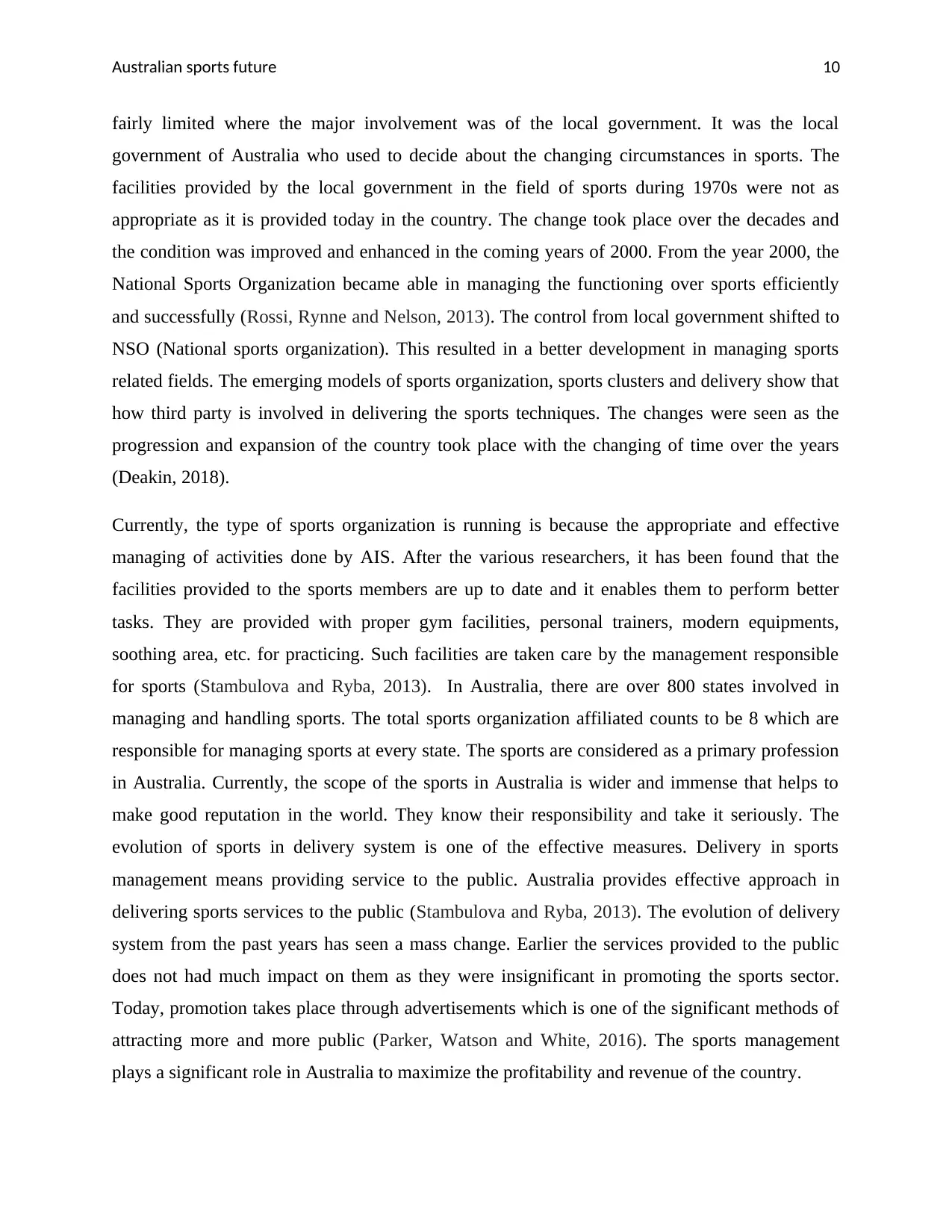
Australian sports future 10
fairly limited where the major involvement was of the local government. It was the local
government of Australia who used to decide about the changing circumstances in sports. The
facilities provided by the local government in the field of sports during 1970s were not as
appropriate as it is provided today in the country. The change took place over the decades and
the condition was improved and enhanced in the coming years of 2000. From the year 2000, the
National Sports Organization became able in managing the functioning over sports efficiently
and successfully (Rossi, Rynne and Nelson, 2013). The control from local government shifted to
NSO (National sports organization). This resulted in a better development in managing sports
related fields. The emerging models of sports organization, sports clusters and delivery show that
how third party is involved in delivering the sports techniques. The changes were seen as the
progression and expansion of the country took place with the changing of time over the years
(Deakin, 2018).
Currently, the type of sports organization is running is because the appropriate and effective
managing of activities done by AIS. After the various researchers, it has been found that the
facilities provided to the sports members are up to date and it enables them to perform better
tasks. They are provided with proper gym facilities, personal trainers, modern equipments,
soothing area, etc. for practicing. Such facilities are taken care by the management responsible
for sports (Stambulova and Ryba, 2013). In Australia, there are over 800 states involved in
managing and handling sports. The total sports organization affiliated counts to be 8 which are
responsible for managing sports at every state. The sports are considered as a primary profession
in Australia. Currently, the scope of the sports in Australia is wider and immense that helps to
make good reputation in the world. They know their responsibility and take it seriously. The
evolution of sports in delivery system is one of the effective measures. Delivery in sports
management means providing service to the public. Australia provides effective approach in
delivering sports services to the public (Stambulova and Ryba, 2013). The evolution of delivery
system from the past years has seen a mass change. Earlier the services provided to the public
does not had much impact on them as they were insignificant in promoting the sports sector.
Today, promotion takes place through advertisements which is one of the significant methods of
attracting more and more public (Parker, Watson and White, 2016). The sports management
plays a significant role in Australia to maximize the profitability and revenue of the country.
fairly limited where the major involvement was of the local government. It was the local
government of Australia who used to decide about the changing circumstances in sports. The
facilities provided by the local government in the field of sports during 1970s were not as
appropriate as it is provided today in the country. The change took place over the decades and
the condition was improved and enhanced in the coming years of 2000. From the year 2000, the
National Sports Organization became able in managing the functioning over sports efficiently
and successfully (Rossi, Rynne and Nelson, 2013). The control from local government shifted to
NSO (National sports organization). This resulted in a better development in managing sports
related fields. The emerging models of sports organization, sports clusters and delivery show that
how third party is involved in delivering the sports techniques. The changes were seen as the
progression and expansion of the country took place with the changing of time over the years
(Deakin, 2018).
Currently, the type of sports organization is running is because the appropriate and effective
managing of activities done by AIS. After the various researchers, it has been found that the
facilities provided to the sports members are up to date and it enables them to perform better
tasks. They are provided with proper gym facilities, personal trainers, modern equipments,
soothing area, etc. for practicing. Such facilities are taken care by the management responsible
for sports (Stambulova and Ryba, 2013). In Australia, there are over 800 states involved in
managing and handling sports. The total sports organization affiliated counts to be 8 which are
responsible for managing sports at every state. The sports are considered as a primary profession
in Australia. Currently, the scope of the sports in Australia is wider and immense that helps to
make good reputation in the world. They know their responsibility and take it seriously. The
evolution of sports in delivery system is one of the effective measures. Delivery in sports
management means providing service to the public. Australia provides effective approach in
delivering sports services to the public (Stambulova and Ryba, 2013). The evolution of delivery
system from the past years has seen a mass change. Earlier the services provided to the public
does not had much impact on them as they were insignificant in promoting the sports sector.
Today, promotion takes place through advertisements which is one of the significant methods of
attracting more and more public (Parker, Watson and White, 2016). The sports management
plays a significant role in Australia to maximize the profitability and revenue of the country.
Paraphrase This Document
Need a fresh take? Get an instant paraphrase of this document with our AI Paraphraser
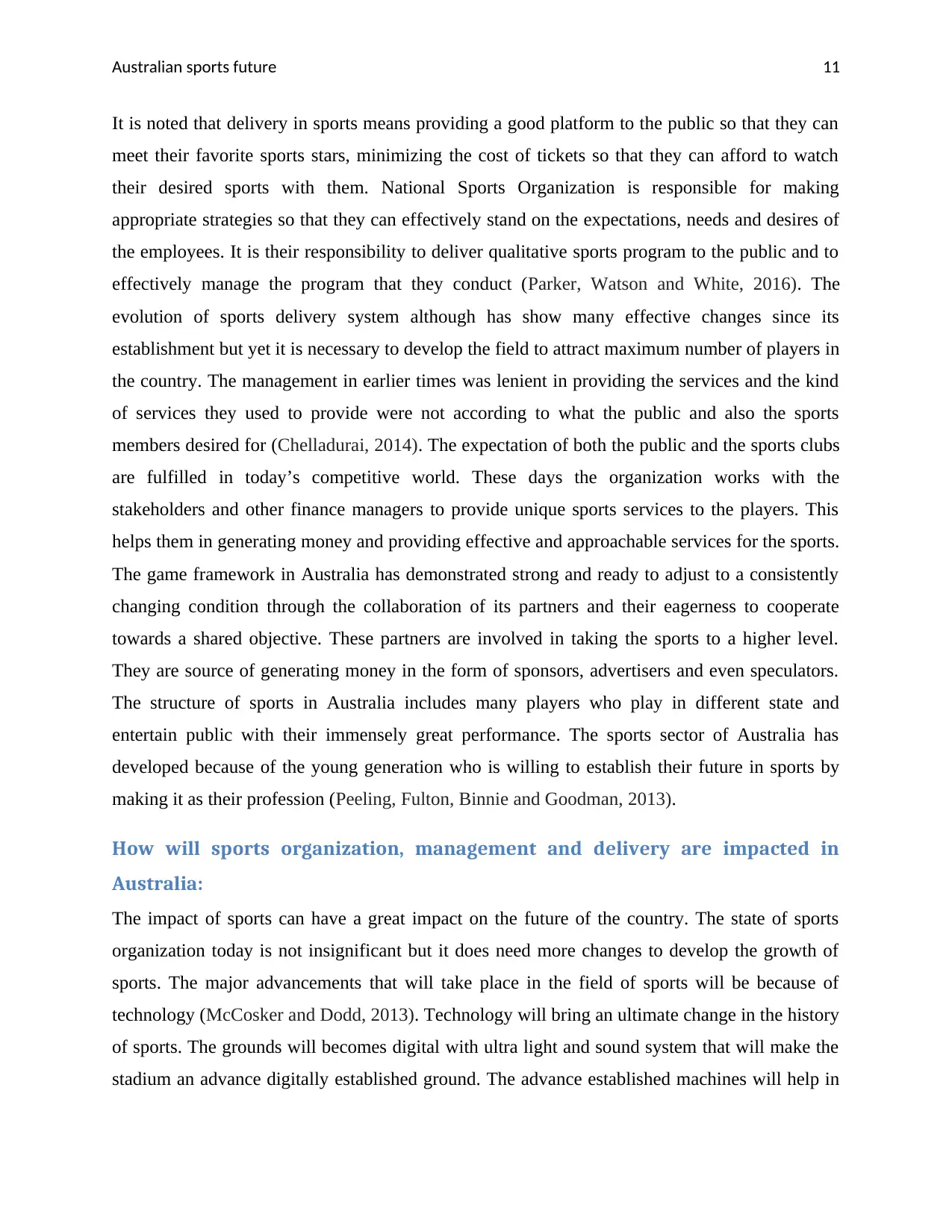
Australian sports future 11
It is noted that delivery in sports means providing a good platform to the public so that they can
meet their favorite sports stars, minimizing the cost of tickets so that they can afford to watch
their desired sports with them. National Sports Organization is responsible for making
appropriate strategies so that they can effectively stand on the expectations, needs and desires of
the employees. It is their responsibility to deliver qualitative sports program to the public and to
effectively manage the program that they conduct (Parker, Watson and White, 2016). The
evolution of sports delivery system although has show many effective changes since its
establishment but yet it is necessary to develop the field to attract maximum number of players in
the country. The management in earlier times was lenient in providing the services and the kind
of services they used to provide were not according to what the public and also the sports
members desired for (Chelladurai, 2014). The expectation of both the public and the sports clubs
are fulfilled in today’s competitive world. These days the organization works with the
stakeholders and other finance managers to provide unique sports services to the players. This
helps them in generating money and providing effective and approachable services for the sports.
The game framework in Australia has demonstrated strong and ready to adjust to a consistently
changing condition through the collaboration of its partners and their eagerness to cooperate
towards a shared objective. These partners are involved in taking the sports to a higher level.
They are source of generating money in the form of sponsors, advertisers and even speculators.
The structure of sports in Australia includes many players who play in different state and
entertain public with their immensely great performance. The sports sector of Australia has
developed because of the young generation who is willing to establish their future in sports by
making it as their profession (Peeling, Fulton, Binnie and Goodman, 2013).
How will sports organization, management and delivery are impacted in
Australia:
The impact of sports can have a great impact on the future of the country. The state of sports
organization today is not insignificant but it does need more changes to develop the growth of
sports. The major advancements that will take place in the field of sports will be because of
technology (McCosker and Dodd, 2013). Technology will bring an ultimate change in the history
of sports. The grounds will becomes digital with ultra light and sound system that will make the
stadium an advance digitally established ground. The advance established machines will help in
It is noted that delivery in sports means providing a good platform to the public so that they can
meet their favorite sports stars, minimizing the cost of tickets so that they can afford to watch
their desired sports with them. National Sports Organization is responsible for making
appropriate strategies so that they can effectively stand on the expectations, needs and desires of
the employees. It is their responsibility to deliver qualitative sports program to the public and to
effectively manage the program that they conduct (Parker, Watson and White, 2016). The
evolution of sports delivery system although has show many effective changes since its
establishment but yet it is necessary to develop the field to attract maximum number of players in
the country. The management in earlier times was lenient in providing the services and the kind
of services they used to provide were not according to what the public and also the sports
members desired for (Chelladurai, 2014). The expectation of both the public and the sports clubs
are fulfilled in today’s competitive world. These days the organization works with the
stakeholders and other finance managers to provide unique sports services to the players. This
helps them in generating money and providing effective and approachable services for the sports.
The game framework in Australia has demonstrated strong and ready to adjust to a consistently
changing condition through the collaboration of its partners and their eagerness to cooperate
towards a shared objective. These partners are involved in taking the sports to a higher level.
They are source of generating money in the form of sponsors, advertisers and even speculators.
The structure of sports in Australia includes many players who play in different state and
entertain public with their immensely great performance. The sports sector of Australia has
developed because of the young generation who is willing to establish their future in sports by
making it as their profession (Peeling, Fulton, Binnie and Goodman, 2013).
How will sports organization, management and delivery are impacted in
Australia:
The impact of sports can have a great impact on the future of the country. The state of sports
organization today is not insignificant but it does need more changes to develop the growth of
sports. The major advancements that will take place in the field of sports will be because of
technology (McCosker and Dodd, 2013). Technology will bring an ultimate change in the history
of sports. The grounds will becomes digital with ultra light and sound system that will make the
stadium an advance digitally established ground. The advance established machines will help in
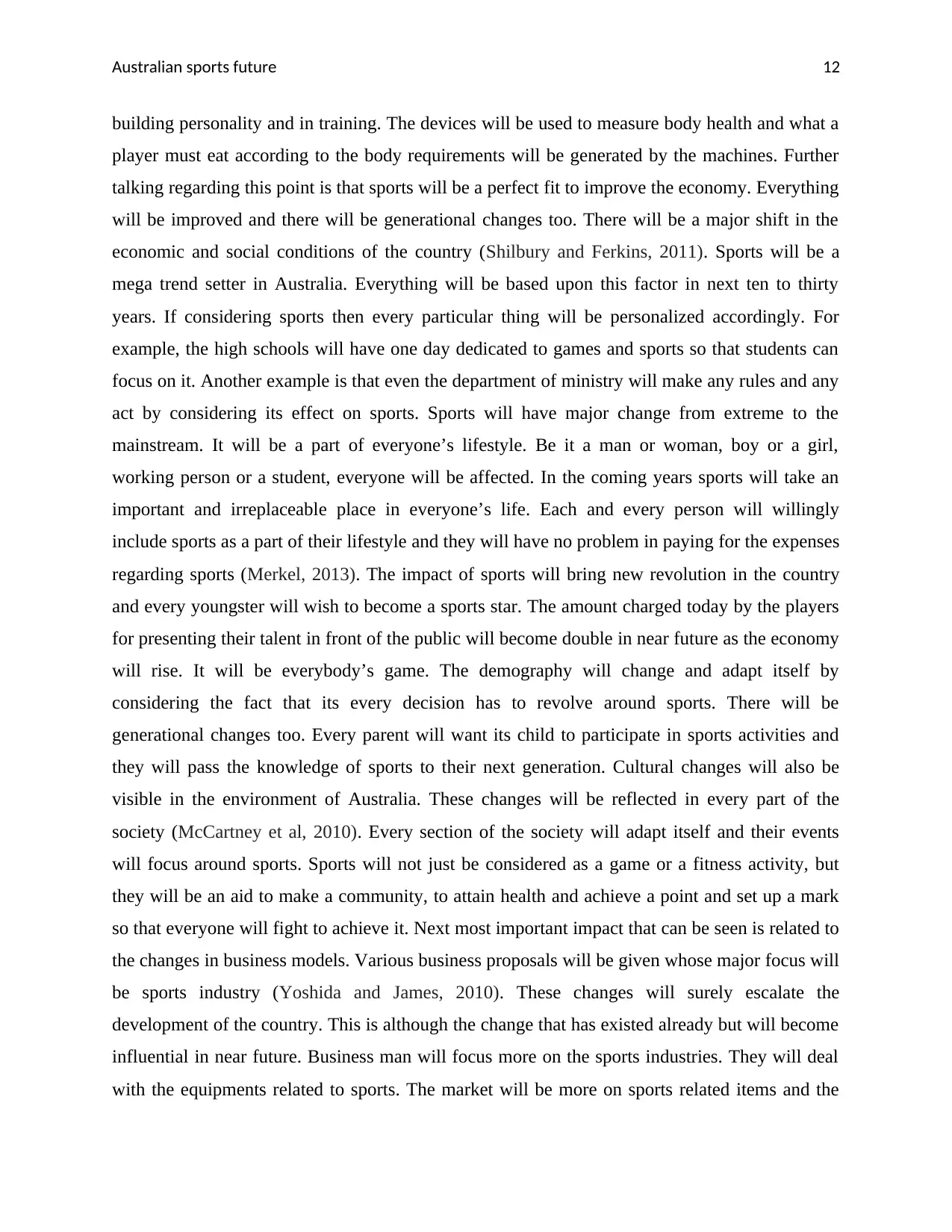
Australian sports future 12
building personality and in training. The devices will be used to measure body health and what a
player must eat according to the body requirements will be generated by the machines. Further
talking regarding this point is that sports will be a perfect fit to improve the economy. Everything
will be improved and there will be generational changes too. There will be a major shift in the
economic and social conditions of the country (Shilbury and Ferkins, 2011). Sports will be a
mega trend setter in Australia. Everything will be based upon this factor in next ten to thirty
years. If considering sports then every particular thing will be personalized accordingly. For
example, the high schools will have one day dedicated to games and sports so that students can
focus on it. Another example is that even the department of ministry will make any rules and any
act by considering its effect on sports. Sports will have major change from extreme to the
mainstream. It will be a part of everyone’s lifestyle. Be it a man or woman, boy or a girl,
working person or a student, everyone will be affected. In the coming years sports will take an
important and irreplaceable place in everyone’s life. Each and every person will willingly
include sports as a part of their lifestyle and they will have no problem in paying for the expenses
regarding sports (Merkel, 2013). The impact of sports will bring new revolution in the country
and every youngster will wish to become a sports star. The amount charged today by the players
for presenting their talent in front of the public will become double in near future as the economy
will rise. It will be everybody’s game. The demography will change and adapt itself by
considering the fact that its every decision has to revolve around sports. There will be
generational changes too. Every parent will want its child to participate in sports activities and
they will pass the knowledge of sports to their next generation. Cultural changes will also be
visible in the environment of Australia. These changes will be reflected in every part of the
society (McCartney et al, 2010). Every section of the society will adapt itself and their events
will focus around sports. Sports will not just be considered as a game or a fitness activity, but
they will be an aid to make a community, to attain health and achieve a point and set up a mark
so that everyone will fight to achieve it. Next most important impact that can be seen is related to
the changes in business models. Various business proposals will be given whose major focus will
be sports industry (Yoshida and James, 2010). These changes will surely escalate the
development of the country. This is although the change that has existed already but will become
influential in near future. Business man will focus more on the sports industries. They will deal
with the equipments related to sports. The market will be more on sports related items and the
building personality and in training. The devices will be used to measure body health and what a
player must eat according to the body requirements will be generated by the machines. Further
talking regarding this point is that sports will be a perfect fit to improve the economy. Everything
will be improved and there will be generational changes too. There will be a major shift in the
economic and social conditions of the country (Shilbury and Ferkins, 2011). Sports will be a
mega trend setter in Australia. Everything will be based upon this factor in next ten to thirty
years. If considering sports then every particular thing will be personalized accordingly. For
example, the high schools will have one day dedicated to games and sports so that students can
focus on it. Another example is that even the department of ministry will make any rules and any
act by considering its effect on sports. Sports will have major change from extreme to the
mainstream. It will be a part of everyone’s lifestyle. Be it a man or woman, boy or a girl,
working person or a student, everyone will be affected. In the coming years sports will take an
important and irreplaceable place in everyone’s life. Each and every person will willingly
include sports as a part of their lifestyle and they will have no problem in paying for the expenses
regarding sports (Merkel, 2013). The impact of sports will bring new revolution in the country
and every youngster will wish to become a sports star. The amount charged today by the players
for presenting their talent in front of the public will become double in near future as the economy
will rise. It will be everybody’s game. The demography will change and adapt itself by
considering the fact that its every decision has to revolve around sports. There will be
generational changes too. Every parent will want its child to participate in sports activities and
they will pass the knowledge of sports to their next generation. Cultural changes will also be
visible in the environment of Australia. These changes will be reflected in every part of the
society (McCartney et al, 2010). Every section of the society will adapt itself and their events
will focus around sports. Sports will not just be considered as a game or a fitness activity, but
they will be an aid to make a community, to attain health and achieve a point and set up a mark
so that everyone will fight to achieve it. Next most important impact that can be seen is related to
the changes in business models. Various business proposals will be given whose major focus will
be sports industry (Yoshida and James, 2010). These changes will surely escalate the
development of the country. This is although the change that has existed already but will become
influential in near future. Business man will focus more on the sports industries. They will deal
with the equipments related to sports. The market will be more on sports related items and the
⊘ This is a preview!⊘
Do you want full access?
Subscribe today to unlock all pages.

Trusted by 1+ million students worldwide
1 out of 18
Your All-in-One AI-Powered Toolkit for Academic Success.
+13062052269
info@desklib.com
Available 24*7 on WhatsApp / Email
![[object Object]](/_next/static/media/star-bottom.7253800d.svg)
Unlock your academic potential
Copyright © 2020–2025 A2Z Services. All Rights Reserved. Developed and managed by ZUCOL.